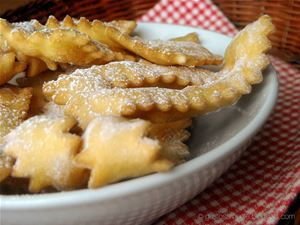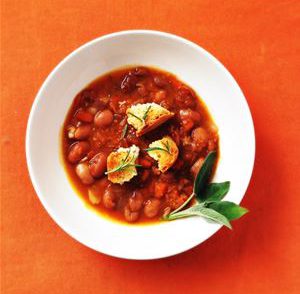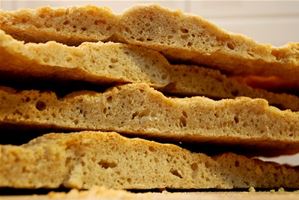Carnival is a time to kick up one’s heels, hide behind a mask, pretend, elaborate, and eat ‘rags.’
For most people, the greatest feature of Carnival season is the elaborate masquerade, and discovering who is behind the masks, meaning both the mask-maker and the person who is thus disguised. It’s a great excuse to let loose while you can, after this long, cold and snowy winter, followed by the onset of Lent with 40 days of no meat, few parties, and generally eating and behaving in an austere way. An old Italian tradition that began in Venice in the fifteenth century, with the party aspect celebrated in cities throughout Italy and the world, Carnival was the only time of year that nobles and paupers could enjoy a meal, a glass of wine and celebrate life together, each person safely hidden behind his or her disguise in an elaborate array of hand-painted masks so no one could identify their origin or status. And they gathered together to eat ‘rags,’ or cenci: delicious pastry morsels unique to Carnival.
In other regions of Italy these cenci are called by their local and familiar names: lattughe (lettuces); nastrini (ribbons); chiacchiere di suora (nun’s gossip); or bugie (lies.) The pastries are fairly similar, but of course every person in every village has a ‘secret’ recipe.
As always, when there is any event, whether it be the changing of the seasons or during Carnival, the first thing I think about is not what to wear, but what to prepare. While others are thinking of masks and masquerades, parades and parties, I am thinking of food, glorious food. Invited to festivities for Carnival, I consider two important things: which event will allow me to prepare the delicious cenci I crave and enjoy making; and whether I can contrive a suitable costume that will not show the sugar I will no doubt powder myself with while crunching!
If you are in Florence and learning Italian, you’ll find that cenci generally means ‘rags.’ Since double meanings abound in Italian, there should be no surprise here. So when in Florence during the carnival, if you are offered cenci, don’t expect to be handed something to wear, or something with which to polish silverware. Accept with grace the trays laden with crunchy ribbons of pastry heavily weighed down in extravagant mounds of mouth-watering zucchero a velo, or powdered sugar. Rough ribbons of dough, fried until crispy in olio di oliva extra vergine, are then drenched in so much confectioner’s sugar that if you don’t get it on your clothes it will be a miracle. Once you take the plunge with your first bite you’ll throw caution to the wind and indulge yourself in the spirit of Carnevale and all it has to offer.

RECIPE
Cenci: fried, sugared ribbons of dough
The origins of why this Italian dessert is named after rags is unclear. It seems to have little to do with the Roman noble family Cenci, which became infamous in the 16th century for filling their family history with horrors such as deceit, murders and beheading.
I relate the name ‘rags’ to the look: these crunchy sweet treats do perhaps look like a pile of rags, with the dough cut with a ragged-edged pastry wheel, placed in an uneven way as pieces crossing over each other, deep-fried then powdered to perfection. Whatever the reason, they are certainly addictive. And for once in quite some time, I am giving you a recipe that is relatively easy to prepare.
A dough that puffs up unevenly when fried, and takes the powdered sugar in uneven spatters too, this is nothing special to look at. Watch out you don’t end up with a powdered sugar moustache when eating these rags, or love bows, or lettuces, or words – or just eat those lies!
Ingredients
250g white flour
50g powdered sugar
A pinch of salt
2 whole egg
Shot glass of Vin Santo
Zest of 1 lemon
30 ml extra-virgin olive oil
Extra powdered sugar to finish
Method
What you need
Wine bottle to roll out the pastry
Deep-fryer (or heavy-based pot for frying)
Wooden zigzag-edged pastry cutter
Sift together the flour and the first measure of powdered sugar, finely grate in the lemon zest. Break the eggs into the centre of the dry ingredients and pour over the Vin Santo and olive oil. Mix by hand into a smooth, firm dough.
Leave to rest 10 minutes in a warm place wrapped in cling film.
Place the dough on a floured surface and roll the dough out into an even 5mm layer using the wine bottle.
With the zigzag cutter, cut the entire layer of pastry into 4cm strips, then follow up by running the cutter down the middle of each strip, making sure to keep the ends of the wider ribbon connected! Pick up each ‘double strip’ by its top edge, twist around loosely and haphazardly with your fingers and promptly drop into hot olive oil.
Remove carefully from the oil once slightly golden and cooked, drain on absorbent paper and cover in sifted powdered sugar.
Buon appetito!
Wine match
This yummy sweet can be crunched on at any time of the day or night during Carnival, and pairs especially well with a very cold glass of Vin Santo.







